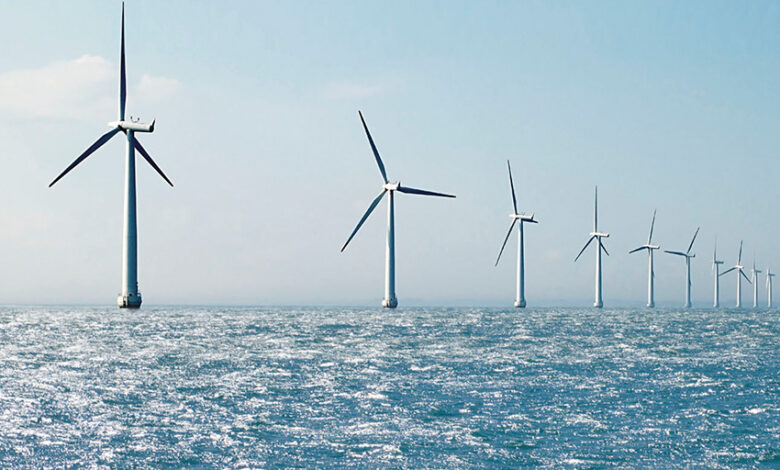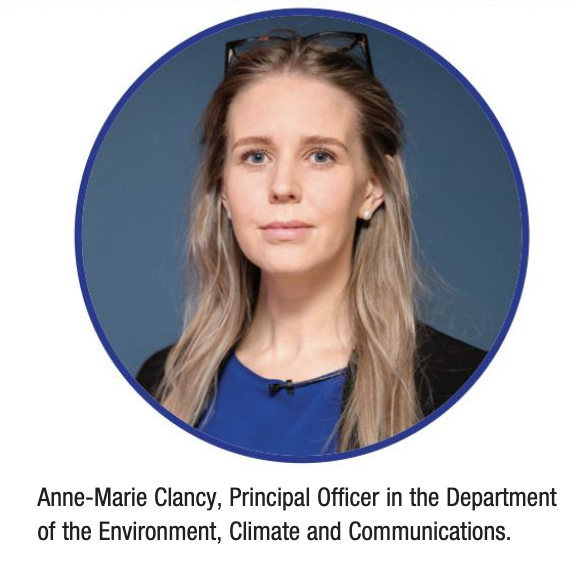Developing Ireland’s offshore wind resources

Anne-Marie Clancy, Principal Officer in the Department of the Environment, Climate and Communications’ (DECC) Offshore Energy – Long-Term Strategic Planning division, outlines a phased approach to post-2030 plan-led offshore development.
 Clancy leads one of three offshore renewable energy divisions within DECC and has specific responsibility for long-term strategic planning.
Clancy leads one of three offshore renewable energy divisions within DECC and has specific responsibility for long-term strategic planning.
She explains that the State has undertaken a huge volume of work over the past 18 months to establish the offshore sector in the context of binding targets, not least its ambitions for 7GW of offshore wind by 2030, 30GW of floating offshore wind beyond 2030 and ultimately, net zero emissions by 2050.
In July 2021, the Department of Housing, Local Government and Heritage launched the National Marine Planning Framework (NMPF), viewed as the overarching framework for decision-making. This was followed by the signing into law of the Maritime Area Planning (MAP) Act 2021, which set out the consenting framework and allowed, for the first time, consenting for development beyond the 12 nautical mile limit, opening the door to floating wind.
Clancy explains that there are two key consents under the legislation. The first is Maritime Area Consent (MAC), which is State consent opening the gateway into the planning permission system. Developers must obtain a MAC before they can go to An Bord Pleanála and this step allows for the State to assess whether a developer is fit and proper to develop in Irish waters.
The second key consent is around formal environmental assessment once a developer has entered the planning permission system. It is also the stage where formal public consultation obligations kick in.
Clancy explains that the enforcement of planning decisions will be undertaken by the new agency, Maritime Area Regulatory Authority (MARA), under the remit of the Department of Housing, Local Government and Heritage, which is expected to be operational by Q2 2023.
Outlining the State’s phased approach to offshore renewable energy development, Clancy highlights the move from the current decentralised regime to a much more “plan-led, centralised” regime. Of the three phases, phases one and two will be critical to Ireland achieving the 7GW by 2030 target, while phase three will be the enduring regime.
Phase one
Under the MAP Act 2021, the Minister for the Environment was granted transitional powers to assess MAC applications from the relevant projects, a group of eight prequalified projects that had significantly progressed under the previous administration. Of these, seven projects are located on the east coast with one located on the west coast. With the first MACs granted in Q4 2022, Clancy says that following assessment of application, the expectation is for some 2.5GW of offshore capacity to be operational by 2030.
“We would expect to see those projects energised from 2027 onwards and we would expect the majority, if not all, to compete in our first Offshore Renewable Electricity Support Scheme [ORESS],” she states.
The ORESS 1 terms and conditions, and auction timetable were published in 2022, with successful applicants to be announced in June 2023.
Phase two
Outlining the approach to phase two, Clancy points to the recognisable gap between phase one’s capacity delivery and the 7GW target. “It was recognised that we do need a second batch of projects coming through the regime before the enduring [phase three] regime kicks in. Our key goal is to get the most realistic and viable projects into the planning pipeline,” she says.
Following extensive consultation on phase two, the responses for which have now been assessed, a policy statement on phase two is expected early this year. Likely to be included in this statement will be whether an ‘innovation’ category, potentially accommodating floating wind into the pipeline before 2030, will be included in a second dedicated offshore renewable electricity support scheme.
The second support scheme will target those phase two projects and also potentially any losers from phase one, with the aim of projects being energised from 2028 onwards, explains Clancy.
Phase three
(the enduring regime)
Describing phase three as the “plan-led regime”, Clancy points out that this stage is for projects expected to be operational beyond 2030 and one where the State is much more involved in determining who, where and when development occurs offshore.
Two work streams are currently underway in the Department in relation to post-2030 development, the first of which is a resource assessment. The Department is currently developing a second offshore renewable energy development plan and this plan is a national resource assessment, analysing the resource potential in the maritime space for a range of technologies from floating through to fixed and tidal. A draft plan will be published for consultation in early 2023.
Clancy explains that the outputs of this second development plan will feed into the Designated Maritime Area Plan (DMAP) process, allowing the State to identify optimal areas for renewable energy development.
“It was recognised that we do need a second batch of projects coming through the regime before the enduring regime kicks in. Our key goal is to get the most realistic and viable projects into the planning pipeline.”
“You will probably see quite a few parallels between the DMAP process and the ‘go-to’ areas the European Commission has referred to in the REPowerEU plans,” says Clancy.
“How far the State goes along that plan-led regime has yet to be determined,” she adds. “The outputs of both the RED III and the DMAP process will feed into that but whether or not the State designates on a site-specific basis or designates particular areas has yet to be determined.”
A second workstream underway in parallel with the resource assessment is that of an economic assessment, which will take account of the upcoming new hydrogen strategy and the update to the electricity interconnection policy.
“We are also carrying out a huge amount of economic analysis, looking at what the route to market might be for projects developing in Irish waters post-2030 and in tandem, looking at what the export potential might be, recognising that a significant amount of our domestic requirements are going to be met by the 2030 timeline.”
Clancy explains that the approach and timing of development post-2030 will be determined by the outputs of both the resource and economic assessments.
Taskforce
Key to delivering this timeline and approach will be the work of the offshore wind taskforce, set up by the Minister for the Environment, Climate and Communications Eamon Ryan TD as one of six delivery taskforces within key strategic areas of the Climate Action Plan. Clancy sets out that the ultimate goal of the taskforce is the development of a master programme plan and the identification of areas where collaboration can accelerate, and drive delivery of the 7GW target.
“The taskforce is going to identify what the critical path is, where the key issues are and whether there are any synergies in the work ongoing amongst the departments and government agencies. As well as identifying what resources are needed and where the resource gaps exist, they will also look to identify infrastructure needs, ranging from supply chains to skills, as well as longer term economic, societal, and business opportunities.
“Further to this, the group is tasked with ensuring alignment between the work that is ongoing to develop the sector and work already underway to protect biodiversity,” Clancy adds.
Concluding, she says: “Work to develop the sector has been ramped up and we are on the cusp of implementing huge change to how we manage our maritime space, ensuring that offshore renewable resource development is done in an efficient and sustainable way. In tandem with that, we are working to develop that post-2030 plan-led regime which will harness and maximise benefits for all users.”





